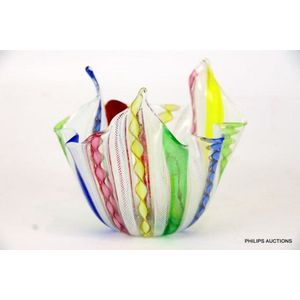Multicolour Murano Latticino Handkerchief Vase
A Murano Latticino handkerchief vase, circa 1950s, the exquisite multicolour fazzoletto (handkerchief) vase, decorated with alternating stripes of white zanfirico lattice filigree, red candy cane and blue, green, pink and yellow ribbons trimmed with copper aventurine, with rough pontil mark to the underside, height 11.5 cm
You must be a subscriber, and be logged in to view price and dealer details.
Subscribe Now to view actual auction price for this item
When you subscribe, you have the option of setting the currency in which to display prices to $Au, $US, $NZ or Stg.
This item has been sold, and the description, image and price are for reference purposes only.
- Pontil Mark - A pontil mark, also known as a pontil scar, is a distinctive mark or scar found on the base of certain types of glass. It is a remnant of the glassblowing process and is particularly associated with handcrafted items made prior to the widespread use of automated manufacturing.
The pontil mark is created during the final stages of production. After the glassblower has shaped and formed the glass object, it is removed from the blowing iron. At this point, the glass object is often attached to a solid rod called a pontil rod or punty for further shaping, finishing, or attaching additional components. The attachment point is typically at the base of the object.
Once the glass item is complete, it is detached from the pontil rod, leaving behind a mark or scar on the base. This mark can take various forms, such as a rough or irregular surface, a concave or slightly recessed area, or a small circular scar. The presence of a pontil mark indicates that the item was handcrafted rather than mass-produced.
Collectors and historians often use pontil marks as clues to determine the age, authenticity, and production methods of glass or ceramic pieces. Different types of pontil marks may suggest different techniques used in the production process. For example, an open pontil mark is one where the scar is left as an exposed, roughened area, while a closed pontil mark occurs when the scar is smoothed or covered in some way. It's important to note that not all handcrafted glass items have pontil marks, as some artisans developed alternative methods for finishing their work. In Edwardian times the pontil mark was oftern ground off leaving a concave circle in the centre of the base of the object.
The use of pontil marks diminished with the advent of industrialization and automated manufacturing processes in the 19th and 20th centuries. - Filigree Work - Decorative Arts - Delicate decorations using fine threads of ceramics, glass or other materials to give a lace-like effect, attached together and applied as an ornament.
- Circa - A Latin term meaning 'about', often used in the antique trade to give an approximate date for the piece, usually considered to be five years on either side of the circa year. Thus, circa 1900 means the piece was made about 1900, probably between 1895 and 1905. The expression is sometimes abbreviated to c.1900.
- Aventurine Glass - Aventurine glass is a type of glass where small flakes of gold, copper, or silver color form in the glass and provide a glitter or sparkle to the glass when seen in the light. The small flakes are created by adding copper, gold or silver to the molten glass during the glassmaking process.
This item has been included into following indexes:
- glass, types or items - aventurine 79
-
Venetian / Murano glass, housewares
- latticino 62
- other 1,199
- vases 620
- vases, handkerchief 20
